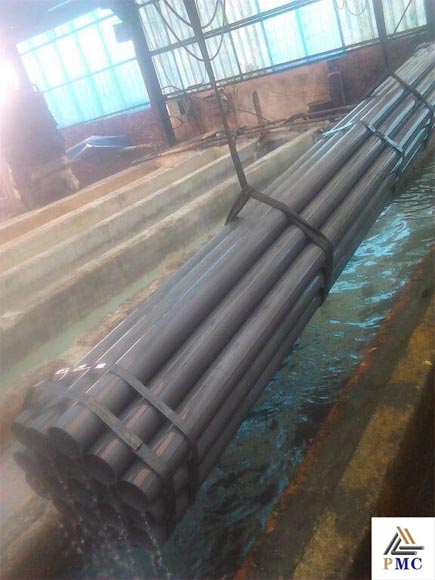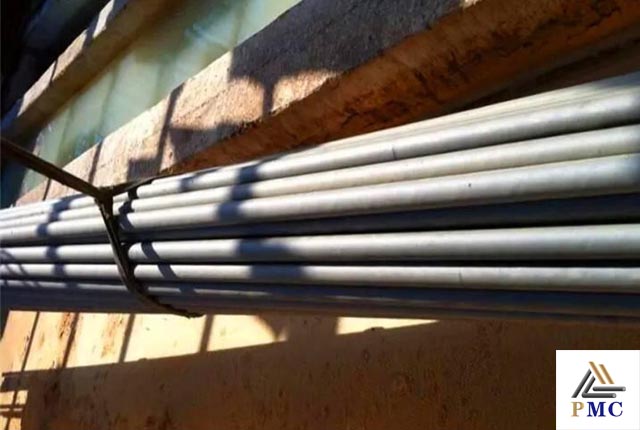
Three Surface Treatment Processes for Seamless Pipes - Pickling, Passivation and Phosphating
Seamless pipe (SMLS) pickling process:
1. Definition of pickling: Acids use chemical methods to remove oxide scale according to a certain concentration, temperature, and speed, which is called pickling.
2. Pickling classification: According to the type of acid: sulfuric acid pickling, hydrochloric acid pickling, nitric acid pickling, hydrofluoric acid pickling. Pickling must use different media according to the material of the steel, such as pickling carbon steel with sulfuric acid and hydrochloric acid, pickling stainless steel with a mixed acid of nitric acid and hydrofluoric acid, etc.
According to the type of pickling equipment: tank pickling, semi-continuous pickling, full continuous pickling, tower pickling.
3. The principle of pickling: pickling is the process of removing the oxide scale on the metal surface by chemical method, so it is also called chemical pickling. Iron oxide scales (Fe203, Fe304, Fe0) formed on the surface of steel pipes are all basic oxides that are insoluble in water. When they are soaked in acid solution or sprayed on the surface, these basic oxides can be A series of chemical changes occur with acid.
Due to the properties of loose, porous and cracked iron oxide scales on the surface of carbon structural steel or low alloy steel, and the repeated bending of iron oxide scales on the pickling unit together with the strip steel through straightening, tension straightening, and transmission, these Pores and cracks further increase and expand, so while the acid solution chemically reacts with the iron oxide scale, it also reacts with the matrix iron of the steel through the cracks and pores. That is to say, at the beginning of pickling, the chemical reactions between the three oxide scales and metallic iron and the acid solution are simultaneously carried out. ⑴ Iron oxide scale reacts with acid to be dissolved (dissolution). ⑵ Metal iron reacts with acid to generate hydrogen gas, which mechanically peels off the iron oxide scale (mechanical peeling effect). (3) The generated atomic hydrogen reduces iron oxides to ferrous oxides which are easy to react with acids, and then reacts with acids to remove them (reduction).
Seamless pipe passivation process:
1. Passivation principle: The passivation mechanism can be explained by the thin film theory, that is, the passivation is due to the interaction between the metal and the oxidizing substance, and a very thin, dense, and good covering performance is formed on the metal surface during the action. Firmly adsorbed to the passivation film on the metal surface. This film exists as a separate phase, usually a compound of oxidized metals. It plays the role of completely separating the metal from the corrosive medium, preventing the metal from contacting the corrosive medium, so that the metal basically stops dissolving and forms a passive state to prevent corrosion.
2. Advantages of passivation:
1) Compared with the traditional physical sealing method, after passivation treatment, it has the characteristics of absolutely not increasing the thickness of the workpiece and changing the color, improving the precision and added value of the product, and making the operation more convenient;
2) Since the passivation process is carried out in a non-reactive state, the passivator can be added and used repeatedly, so the service life is longer and the cost is more economical. the
3) Passivation promotes the formation of a passivation film of oxygen molecular structure on the metal surface, which is compact and stable in performance, and has a self-repairing effect in the air at the same time. Therefore, compared with the traditional method of applying anti-rust oil, the passivation formed The passivation film is more stable and corrosion resistant.
Most of the charge effects in the oxide layer are directly or indirectly related to the thermal oxidation process. In the temperature range of 800-1250 ° C, the thermal oxidation process with dry oxygen, wet oxygen or water vapor has three continuous stages. First, the oxygen in the ambient atmosphere enters the formed oxide layer, and then the oxygen passes through the carbon dioxide Silicon diffuses to the inside, and when it reaches the SiO2-Si interface, it reacts with silicon to form new silicon dioxide. In this way, the oxygen entry-diffusion-reaction process continues to occur, so that the silicon near the interface is continuously converted into silicon dioxide, and the oxide layer grows to the inside of the silicon wafer at a certain rate.

Seamless pipe phosphating process:
The phosphating treatment process is mainly used on the metal surface, the purpose is to provide a protective film for the metal surface, to isolate the metal from the air and prevent it from being corroded; it is also used as a primer before painting some products. The chemical film can improve the adhesion and anti-corrosion ability of the paint layer, improve the decoration and make the metal surface look more beautiful, and can also play a lubricating role in the cold working process of some metals.
After phosphating treatment, the workpiece will not be oxidized and rusted for a long time, so phosphating treatment is widely used, and it is also a commonly used metal surface treatment process. It is used more and more in industries such as automobiles, ships, and machinery manufacturing. more and more.
Classification and application of phosphating:
Usually, a surface treatment shows one color, but phosphating treatment can show different colors by using different phosphating agents according to actual needs, which is what we often see phosphating Handles are available in grey, colored or black.
1. Zinc-based phosphating: also known as gray phosphorus, it forms a gray-dark gray phosphating film, and the phosphating film weighs 1.5-3.5g/m2. It is mainly used for coating the bottom layer to improve the bonding force and anti-corrosion ability of the coating.
2. Iron-based phosphating: also known as color phosphorus, it forms a blue-golden-iridescent phosphating film, and the phosphating film weighs 0.3-0.6g/m2. It is mainly used for coating the bottom layer, improving the bonding force and anti-corrosion of the coating ability.
3. Four-in-one phosphating: complete the functions of oil removal, rust removal, scale removal, and phosphating at one time, forming a blue-blue-purple-gray phosphating film, which is used for pre-painting treatment of large-scale equipment and small batch production.
Go here to learn more about " Introduction and Advantages of Galvanizing Process "


